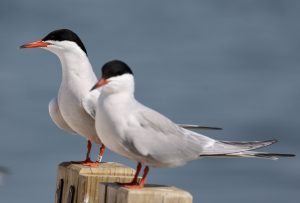
The gull numbers on the raft had been continually (unfortunately) increasing the past couple of weeks, with only a few Common Terns trying to take their raft back. When the gull numbers were up to about 100, we decided to intervene. That’s too many for so few terns to keep off the raft. They were predominantly immature Herring and Great Black Backed Gulls, so they weren’t trying to nest, but they were not allowing the terns to settle on their raft. Just teenagers trying to find a place to hang out.
Something had to be done to give the terns their raft back, since the raft was created for the terns.
Coastal Bird Conservation Specialist Kim Abplanalp and MD DNR Seasonal Tech Tech Maggie positioned themselves in a boat near the raft and would approach every time the gulls tried to land. They did this for most of a day and the continued presence didn’t deter the terns who were happy to finally have their raft back and started building scrapes (nests) and establishing nesting territories immediately. We can’t say for certain that it was only because of the human presence, but the day of babysitting the raft (aka Operation Save the Raft) seemed to be all it took, and we haven’t seen any gulls on the raft since. Hooray!
The number of terns is over 100 so far, and we have resighted 47 banded terns! That accounts for 14 out of 19 of those banded in 2021 and 31 of the 91 we banded in 2022. It’s still early and new terns are showing up daily, so we expect to see more banded terns. We also found 54 scrapes already, but no eggs yet. We think by this week there will be eggs! The first eggs showed up last year between May 20-24, which may have been delayed by the nor’easter that lingered off the coast from May 6-13.
For the past week, since successfully persuading the loafing teenage gulls to find a new hangout spot, the terns have been busy establishing territories, building scrapes (nests), and, most importantly, engaging in courtship behavior. Part of that involves the male bringing delicious fish for his partner to eat, which he presents while keeping his head down. They will also fly together in aerial courtship displays, sometimes with the male carrying a fish. Most pairs stay together year after year, but they still perform courtship displays at the beginning of each breeding season. They strengthen their bond by using their bodies to make a depression in the shells which forms a nicely shaped scrape to hold their eggs. And it ends with copulation, which the terns were doing a lot of last week!
We will let you all know when the first eggs are laid! Stay tuned……
